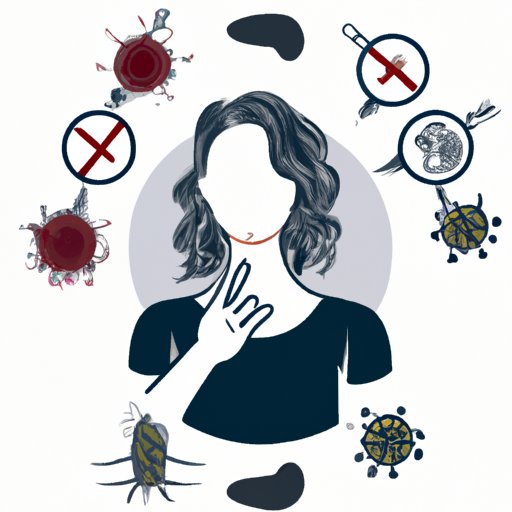
Introduction
Hives, also known as urticaria, are a common skin reaction that causes red, itchy bumps on the skin. While hives are often attributed to allergic reactions, they can also be a symptom of underlying health conditions, including autoimmune diseases.
In this article, we’ll explore the link between autoimmune diseases and hives, why it’s important to understand this connection, and ways to manage symptoms and improve the quality of life for individuals with autoimmune-related hives.
The Link Between Autoimmune Diseases and Hives: What You Need to Know
Autoimmune diseases are conditions in which the body’s immune system mistakenly attacks healthy cells. Hives can be a symptom of autoimmune diseases because the immune system causes an inflammatory response in the skin, resulting in the development of hives.
A study published in the Journal of Allergy and Clinical Immunology found that up to 40% of individuals with chronic hives may also have an underlying autoimmune disorder.
Understanding the Connection: Autoimmune Disorders and Hives
Autoimmune disorders occur when the immune system fails to recognize healthy cells and tissue, attacking them as if they are foreign invaders. This results in inflammation, which can trigger hives and other symptoms.
There are various types of autoimmune disorders, including lupus, rheumatoid arthritis, and celiac disease, that can cause hives.
Hives can also be categorized into acute and chronic forms. Acute hives typically last less than six weeks and are often caused by allergens or medication. Chronic hives last more than six weeks and are often associated with autoimmune diseases.
Common Autoimmune Disorders That Cause Hives and How to Treat Them
Some of the autoimmune diseases that may cause hives include lupus, rheumatoid arthritis, and Hashimoto’s thyroiditis.
Common symptoms of lupus include joint pain, fatigue, and a butterfly-shaped rash on the face. Treatment for lupus often involves medications to control inflammation and immunosuppressants to prevent the immune system from attacking healthy cells.
Rheumatoid arthritis is a condition that causes joint pain, stiffness, and swelling. Other symptoms may include fatigue and fever. Treatment options for rheumatoid arthritis include medications to reduce inflammation, physical therapy, and joint replacement surgery in severe cases.
Hashimoto’s thyroiditis is an autoimmune disorder that targets the thyroid gland, resulting in an underactive thyroid. Symptoms of this condition include fatigue, weight gain, and dry skin. Treatment often involves hormone replacement therapy to restore normal thyroid levels.
The Impacts of Autoimmune-Related Hives on Quality of Life
Living with hives and autoimmune diseases can have a significant impact on an individual’s quality of life. Hives can be uncomfortable and itchy, and individuals may feel self-conscious about their appearance.
Managing autoimmune symptoms can also be challenging, particularly if the condition is chronic. Fatigue, joint pain, and other symptoms can make it difficult to carry out everyday activities and may contribute to mood disorders such as depression and anxiety.
Fortunately, there are resources available to help individuals cope with these challenges. Support groups, counseling, and medication management can all help improve quality of life for individuals with hives and autoimmune diseases.
Exploring the Relationship Between Hives and Autoimmune Diseases
While autoimmune diseases can be a cause of hives, other factors may also trigger the development of hives in individuals with underlying autoimmune diseases. These triggers may include stress, environmental factors, and certain medications.
Additionally, the development of hives may impact the course of autoimmune diseases. Hives may exacerbate existing symptoms and cause inflammation that could contribute to disease progression.
For this reason, it’s important for individuals with autoimmune diseases to work with their healthcare providers to identify potential triggers and develop strategies to manage symptoms and improve overall health.
Autoimmune Diseases that Often Present with Hives: A Comprehensive Overview
There are various autoimmune diseases that may cause hives, and an accurate diagnosis is key to developing an effective treatment plan.
Other autoimmune diseases that may cause hives include psoriasis, Sjogren’s syndrome, and vasculitis.
Psoriasis is a condition that causes patches of scaly, red skin. In some cases, psoriasis may also cause hives. Treatment options for psoriasis include topical medications, oral medications, and light therapy.
Sjogren’s syndrome is a condition that affects the body’s moisture-producing glands, leading to dry eyes and mouth. Sjogren’s syndrome may also cause hives. Treatment for this condition may include medications to control inflammation and immunosuppressants.
Vasculitis is a condition that causes inflammation in the blood vessels, leading to skin rashes, joint pain, and other symptoms. Hives may also be a symptom of vasculitis. Treatment options for this condition may involve medications to reduce inflammation and immunosuppressants.
Conclusion
Overall, hives can be a symptom of underlying autoimmune diseases, and an accurate diagnosis is important to develop an effective treatment plan. Managing symptoms and maintaining overall health can help improve an individual’s quality of life. If you’re experiencing hives or autoimmune-related symptoms, seeking medical help is a crucial step in managing your health.




